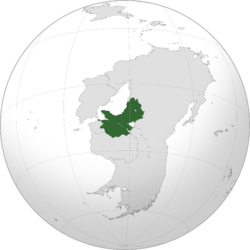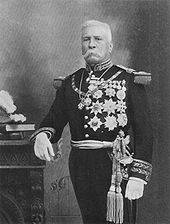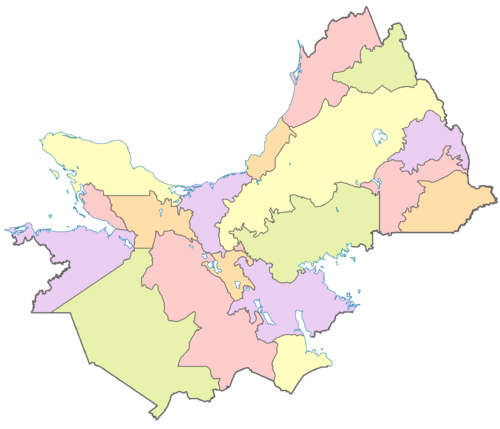Nadauro: Difference between revisions
| Line 110: | Line 110: | ||
{{See also|Nadauran Wars of Independence|First Empire of Nadauro|Glorious Revolution (Teleon)|United Provinces of Nadauro|Second Empire of Nadauro|Apreensão (Teleon)|Statist Nadauro}} | {{See also|Nadauran Wars of Independence|First Empire of Nadauro|Glorious Revolution (Teleon)|United Provinces of Nadauro|Second Empire of Nadauro|Apreensão (Teleon)|Statist Nadauro}} | ||
Tensions between the X and New Pania came to a head when [[X's]] [[invasion of X]] in 180X caused dramatic upheaval in the colonial empire. New Panian demands for unyielding resistance, criticism of wartime | Tensions between the X and New Pania came to a head when [[X's]] [[invasion of X]] in 180X caused dramatic upheaval in the colonial empire. New Panian demands for unyielding resistance, criticism of wartime {{wp|fiscal policy}} overseas, the establishment of sovereign town councils (''{{wp|cortes}}''), and above all the fallout of the [[Great Revolution (Teleon)|Great Revolution]] in neighboring [[Darona]] prompted political figures of the elites to raise questions on autonomy and outright independence. On 16 August 1819, protestors around [[Teresa Leopoldina de Alvárez]] published their radical [[Appeal of Sangosto]], for which they were promptly arrested and {{wp|execution by firing squad|executed by firing squad}} on the same day; Teresa's husband, colonel [[Emperor of Nadauro|Luís Alfonso de Alvérez]], and the [[Council of Five (Nadauro)|Council of Five]] subsequently [[Declaration of Independence of Nadauro|declared]] the colony's independence from X. | ||
The [[Nadauran Wars of Independence]], which was already initiated by the [[Nadauran Wars of Independence|Tenothlan revolt]] in the [[Cisyaotla]] province on 30 March, rapidly engulfed the entire country. The [[Battle of As Cachoeiras]] on 6 June 1820 proved to be the decisive victory for the New Panian armies; the last X soldiers surrendered in August of 1820, and on 3 March 1821, X recognized its {{wp|sovereignty}} with the [[Treaty of X (1821)|Treaty of X]]. A month later, the now-{{wp|national hero}} Luís Alfonso was proclaimed the first [[Emperor of Nadauro]] in Forte de Agosto, and the [[First Empire of Nadauro]] was established. | The [[Nadauran Wars of Independence]], which was already initiated by the [[Nadauran Wars of Independence|Tenothlan revolt]] in the [[Cisyaotla]] province on 30 March, rapidly engulfed the entire country. The [[Battle of As Cachoeiras]] on 6 June 1820 proved to be the decisive military victory for the New Panian armies; the last X soldiers surrendered in August of 1820, and on 3 March 1821, X formally recognized its {{wp|sovereignty}} with the [[Treaty of X (1821)|Treaty of X]]. A month later, the now-{{wp|national hero}} Luís Alfonso was proclaimed the first [[Emperor of Nadauro]] in Forte de Agosto, and the [[First Empire of Nadauro]] was established. | ||
''TBD'' | |||
[[File:Porfirio Diaz in uniform.jpg|170px|thumb|right|[[Emanuel Teixeira]], one of the most influential Nadauran statesmen in the 19th century]] | [[File:Porfirio Diaz in uniform.jpg|170px|thumb|right|[[Emanuel Teixeira]], one of the most influential Nadauran statesmen in the 19th century]] | ||
Revision as of 11:47, 10 June 2024
This article is incomplete because it is pending further input from participants, or it is a work-in-progress by one author. Please comment on this article's talk page to share your input, comments and questions. Note: To contribute to this article, you may need to seek help from the author(s) of this page. |
United Nadauran States Estados Unidos Anadaúroleiros (Lavish) | |
|---|---|
| Motto: Suum Cuique (Cambran) ("To Each Their Own") | |
| Anthem: Hino Nacional Anadaúroleiro ("Nadauran National Anthem") | |
| National seal Selo Nacional do Anadaúro National Seal of Nadauro  | |
 Location of Nadauro (dark green) | |
| Capital and largest city | Itabira |
| Official languages | Lavish (de facto) |
| Ethnic groups | 41.5% White 37.7% Multiracial 11.1% Black 6.8% Indigenous 1.9% Abarian |
| Religion | 78.8% Gregorianism —X 13.0% No religion 6.1% Spiritism 2.1% Other |
| Demonym(s) | Nadauran |
| Government | Federal presidential constitutional republic |
| Nataniel Magalhães | |
| Erasmo Câmara | |
| Gracília Couto Pimentel | |
| Tadeu Soares de Brugge | |
| Legislature | National Congress |
| Senate | |
| Chamber of Representatives | |
| Independence from Lavaria | |
• Declared | 16 August 1819 |
| 3 March 1821 | |
| 20 April 1979 | |
| 7 July 1983 | |
| Area | |
• Total | 1,298,032 km2 (501,173 sq mi) |
• Water (%) | 0.74% |
| Population | |
• December 2022 estimate | 139,411,400 |
• 2020 census | 136,962,171 (4th) |
| GDP (PPP) | 2022 estimate |
• Total | |
• Per capita | |
| GDP (nominal) | 2022 estimate |
• Total | |
• Per capita | |
| Gini (2021) | high |
| HDI (2020) | high |
| Currency | Nadauran lirio (L$, NAL) |
| Time zone | UTC-8 |
| Date format | dd/mm/yyyy (CE) |
| Driving side | right |
| Calling code | +40 |
| Internet TLD | .na |
Nadauro (/nɑːdɑːˈuːroʊ,
The nation's society is among the most ethnically diverse and multicultural ones in the world. Approximately two-thirds of its population practices Gregorianism to an extent, making it the single most populous X-majority country; Nadauro is also the only country in Elia to have Lavish as its de facto official language. Its varied geography and high density of biodiversity shape the megadiverse country, ranging from the tropical rainforest of the X basin to the wetlands of the Mécalin peninsula and the Haitetl Desert.
The area of modern-day Nadauro has seen continuous human presence going back to 7,000 BCE in the late Paleolithic period. From the 6th and 5th centuries BCE onward, the Rift Valley of Nadauro gradually became one of the world's cradles of civilization, spawning a number of subsequent princely polities and city-states such as the Necaha, Cozahetl, Etalco, Mecatl, and the Ata cultures, and ultimately the expansive and hegemonic Huecean Empire by the first millennium AD. Calesian contact in 1505 precipitated the eventual conquest of the Huecean Empire by the Lavish Empire in 1547, leading to the civilization's swift collapse and the establishment of the colony of New Pania. The abundance of its mineral deposits, namely silver and gold, greatly contributed to Lavaria's rise as a global colonial power in the 17th century and the eventual elevation of New Pania to the status of a kingdom in 1732. After nearly three centuries of colonial rule, Nadauro achieved independence in 1819 following the successful Great Revolution in Darona as a constitutional monarchy under Emperor Luís I.
The political and economic upheaval of the newly independent nation state, caused in part by the Helmish War, culminated in a military coup d'état in 1858 and a Waldrich-backed royalist counter-coup in 1859. Efforts to introduce liberal reforms in the Constitution of 1874 saw brief flirtation with civil republicanism during the August War through the creation of the United Provinces of Nadauro; slavery was abolished in 1876. The short-lived federation would come to an end with the imposition of a royalist dictatorship under Emanuel Teixeira after the First Helmish–Nadauran War and 1885 National Schism, pursuing rapid modernization and industrialization. The rise of militarism and imperialist ambitions of the Empire coincided with the introduction of national syndicalism through Lúcio Cabral's seizure of power in 1921, in the wake of the 1909 Second Helmish–Nadauran War; Nadauro invaded Helmenland in 1934 and officially entered the Great War as an Sydenham Power in 1936. Ultimately, Nadauro surrendered in 1940 amidst total defeat and was occupied by Transmedan forces until 1950. The tenure of the new democratic monarchy under Emperor Luís IV would be interrupted by a violent military junta in the mid-1970s, which was itself overthrown by a return to civilian rule and the final abolition of the monarchy in 1979. Despite spectacular economic growth, Nadauro has suffered from a low-intensity, asymmetric armed conflict in Chaibia and political violence beginning in the 1980s.
Nadauro is a federal presidential constitutional republic, led by a President, as both head of state and head of government under a multi-party system; the current system was defined in the constitution introduced in 1983. The federated nation is composed of 15 states, 3 autonomous republics, and the Federal District. The developing and newly industrialized country is regarded as a historical regional or middle power, an emerging power of note in contemporary international affairs, and generally considered to be one of the world's leading emerging markets with the 5th-largest economy by nominal GDP and the 6th-largest by PPP. However, high income inequality, poverty, extensive crime, and corruption continue to plague the country. Nadauro is a founding member of the United Congress (UC), the Organization of Elian States (OES), X.
Etymology
The name of the country "Nadauro" may be derived from a shortened and abridged expression in the Lavish language, "banhado a ouro", meaning "gold plated" or "bathed in gold", from banhado ("bathe" or "steeped"), the preposition a ("in" or "with"), and ouro ("gold").
It is possibly in reference to the decorative use of gold for armor by the Huecean Empire beginning in the mid-1300s; multiple historical accounts, including conquistador Pedro Gárcia de Semhanas, confirm the presence of warriors clad in their ceremonial attire at the 1546 Parley of Tlecupilxan alongside Emperor Yolotzil, though no mention of their armor being plated in sheets or specks of gold specifically was ever made. Other sources allege the use of the expression was the result of the noted supposed abundance of gold within the Huecean Empire in its entirety, or even in reference to a metaphor for the sun rising in the east.
Although "Nadauro" had quickly achieved widespread public use as an epithet by the mid-17th century, the country was formally named "Vice-kingdom of New Pania" (Virreinato do Novo Pánia) by the Lavish Empire for the entirety of its colonial history, until it supplanted the latter when independence was achieved in 1819. From 1819–1858, from 1859–1874, and from 1885–1979 it was named the "Empire of Nadauro" (Império do Anadaúro; the period from 1885 to 1950 is referred to as the "Second Empire", and the "Third Empire" from 1950 to 1979), in 1858 "Republic of New Pania" (República do Novo Pánia), from 1874–1885 "United Provinces of Nadauro" (Províncias Unidas do Anadaúro), and since 1979 "United Nadauran States" (Estados Unidos Anadaúroleiros). However, the 1819 Constitutional Congress of Veracrúz referred to the modern-day Nadauran territory as "Central Elia" (Élia Central) in its constitutional draft and declaration of independence; subsequent constitutions in 1874, 1886, and 1923 each used the names "Nadauran Republic" (República do Anadaúro), "New Panian and Nadauran Union" (União Novo Pániaco e Anadaúroleiro), and "Nadauran Nation" (Nação Anadaúroleiro), respectively.
History
Pre-Calesian era (pre-1547)
Lavish conquest and colonization (1547–1819)
Independence, early republics, and empire (1819–1940)
Tensions between the X and New Pania came to a head when X's invasion of X in 180X caused dramatic upheaval in the colonial empire. New Panian demands for unyielding resistance, criticism of wartime fiscal policy overseas, the establishment of sovereign town councils (cortes), and above all the fallout of the Great Revolution in neighboring Darona prompted political figures of the elites to raise questions on autonomy and outright independence. On 16 August 1819, protestors around Teresa Leopoldina de Alvárez published their radical Appeal of Sangosto, for which they were promptly arrested and executed by firing squad on the same day; Teresa's husband, colonel Luís Alfonso de Alvérez, and the Council of Five subsequently declared the colony's independence from X.
The Nadauran Wars of Independence, which was already initiated by the Tenothlan revolt in the Cisyaotla province on 30 March, rapidly engulfed the entire country. The Battle of As Cachoeiras on 6 June 1820 proved to be the decisive military victory for the New Panian armies; the last X soldiers surrendered in August of 1820, and on 3 March 1821, X formally recognized its sovereignty with the Treaty of X. A month later, the now-national hero Luís Alfonso was proclaimed the first Emperor of Nadauro in Forte de Agosto, and the First Empire of Nadauro was established.
TBD

The issue of taxation and Chaibian independence formed a widening divide between Duarte and Vice President Luís Benito de Gerosa and general Emanuel Teixeira that escalated into the National Schism in April of 1885. A military coup d'état led by Teixeira restored power to the popular Pedro I as Emperor and imposed a royalist junta, called the Teixeirato; from 1890 to 1920, Nadauro underwent a period of large-scale industrialization, militarization, and centralization. Unlike most of the Eastern Hemisphere's republics in the latter 19th century, the Empire witnessed vibrant economic and population growth as well as political stability. The successful Second Helmish–Nadauran War in 1909 and X in 19X cemented Nadauro's international position as an emerging great power.
Emergency management incompetency following the 1919 Great Itabira Earthquake and a failed coup led to a rise of political militarism, nationalism and ultimately national syndicalism; Lúcio Cabral of the Statist Party assumed the position of prime minister under Luís III on 20 June 1921 and initiated the era of totalitarian Statist Nadauro. This ideological shift and the economic turmoil of the Recession of 1924 prompted Nadauro to pursue economic autarky, an aggressive foreign policy of expansionism and imperialism (Esfera legítima), and military alliances with Asplinist Falland and Razan. During the Third Helmish–Nadauran War in 1934, Nadauro consolidated its territorial ambitions and conducted a pacifying genocide against the X.
On 8 August 1936, Statist Nadauro officially entered the Great War as a Sydenham Power and was initially vastly successful in its military campaigns; by 1937, Nadauro controlled almost the entirety of northern Elia Austral and encroached upon the Free States south coast. However, a series of Transmedan victories at X and X, as well as the failed attempted invasion of the Free States forced Nadauro to adopt a strictly defensive strategy from 1938 onwards. Transmedan landings in X and Yecahual led to the fall of the Statist regime and an unconditional surrender by the rump government on 25 March 1940.
Contemporary era (1940–)
In the wake of the Great War, Nadauro was occupied by Transmedan forces and governed by the Control Council. Under its supervision, a new constitution was enacted on 10 August 1950 and abdicated Agustín I's son, Luís IV, became Emperor, despite fierce protests by Nadauran republicanists. Nadauro was stripped of all of its overseas territories, formally ending the Nadauran colonial empire, and millions of Nadauran settlers were repatriated from the former colonies throughout Elia Austral and beyond. The International Military Tribunal for the Elias was convened to prosecute Nadauran leaders except for Emperor Agustín I for war crimes; 29 accused were executed and another 50 incarcerated. Transmedan occupation ended with the Treaty of Fastings on 11 August 1950; in 1955, Nadauro was granted membership in the United Congress.
Fears of a combinationalist takeover prompted post-war prime minister Osmar Caetano Paschoal to assume a conciliatory posture towards the fledging opposition in parliament and govern without major crises. Concurrently, a period of record growth revived and propelled Nadauro's economy to become the fifth-largest one in the world. Beginning in the 1960s, Nadauro pursued a foreign policy of rapprochment with Waldrich and the Free States in particular, exemplary in the 1964 membership entry in the X.

Luís IV's dismissal of Julio Vila's centre-left government in December of 1973 prompted a tenure of political turbulence and precipitated a right-wing coup by a military junta; Hermes Caravelas intended to assume power for a transitory period but soon solidified his perpetual grip; despite the suspension of civil rights and introduction of strict authoritarianism, international protest was futile and economic growth continued to accelerate.
The plateauing of economic development and rapid hyperinflation after a series of mismanaging decisions and international pressure by sanctions led to the Forte de Agosto University protests on 19 May 1978. The Renascimento came in response to its brutal suppression with the Águaboa massacre, which deposed the weakened military government and brought about a peaceful transition of power from Caravelas to main opposition leader Enrico Pimentel. A nationwide referendum on 9 April precipitated the promulgation of a democratic and republican constitution, which chose not to restore the monarchy under Luís IV. On 20 April 1979, the modern United Nadauran States was founded.
The power vacuum left by the political turmoil in the Nadauran countryside was not without effect; in 1982, an asymmetric low-intensity conflict between the government military, left-wing guerrilla groups (FLP, ER1M), reactionary right-wing paramilitary bands (CLUN), and drug cartels (Armala cartel, Nahia cartel) becoming embroiled in the production, processing, and export of primarily marijuana and cocaine broke out in the state of Chaibia. President Pimentel remained staunchly opposed to negotiations and was assassinated on 30 September 1985 by ER1M.

From 1987–1992, the United Congress intervened in Nadauro with the United Congress Observer Mission in Nadauro (UCOMCA) to aid in its peace process. Juan Manuel Duque pursued a controversial peace policy during his tenure in the late 1980s, negotiating the disbanding of CLUN and a temporary truce with FLP and ER1M; the peace deal fell apart when the rejecting National Congress moved against Duque with a vote of no-confidence in January of 1988, and by 1989, the conflict had escalated into open rebellion. Diplomatic efforts by successor Tadeu Espíndola culminated in the Easter Agreement of 1990, which pacified the conflict into the largely dormant state it has been ever since.
Espíndola embarked on sweeping neoliberal reforms aimed at combating the Nadauran coroa crisis and signing the Elian Free Trade Agreement (EFTA) with the Free States and X in 1989. A second period of economic prosperity accompanied his tenure throughout the 1990s, seeing a peak growth rate of 6.2% in 1995; Nadauro hosted the 1996 Summer Olympics in Itabira. Contemporary Nadauran politics has been dominated by the intense rivalry between the conservative National Action Party (PAN) and the 2002-founded, progressive catch-all National Democratic Party (PDN); major political crises and events in 21st-century Nadauro include the kidnapping and murder of Dolores Peixoto in 2001, the 2004 impeachment of President Luciana Chagas, the 2010 Debelcom corruption scandal, the 2011 abortion protests, and the 2013 government protests.
Geography
Nadauro is situated at the southern coast of the Helmish Sea of Elia Austral, bordering X to the north, X to the east, X to the south, and X to the west. Furthermore, it is bound by Lake Louis to the southeast, Elia Austral's largest lake, and Lake Namatla, the country's deepest lake. The territorial extent of Nadauro covers an area of 1,298,032 km2 (or 501,173 sq mi), 0.74% or 9,605.4 km2 (3,708.7 sq mi) of which are areas of water; this makes Nadauro the largest country by size in the Elias and the third-largest in the world. It lies between latitudes 7° and 24° S and longitudes 83° and 104° E.
Being one of the world's three megadiverse countries, its most notable feature is the abundance of diverse topographical and geological assets, having been amassed throughout its turbulent geographical history. The Serra do Sol in the southeast of the country are the highest elevated areas of Nadauro, with the Ilhuimara (at 5,401 meters or 17,720 feet) as its peak, while numerous collections of mountains and small ranges (most notably the Serra Vermelhas in the south and the Ixnite Mountains in the southwest) comprising the Rift Valley of Nadauro dot the country's central highlands region. The coastal areas are dominated by two low-lying arable and lightly forested plains, forming the Helmish Sea Coastal Plain and the Mécalin peninsula. To the north, the X basin forms a large drainage basin comprising the vast majority of northern Elia Austral, separated from the remainder of Nadauro by the Neblina Highlands.
Nadauro is traversed by a vast and dense network of major rivers, all of which drain into the Medan Ocean; the most notable of which include the Pórena (a major tributary of the X), the Branco, Yaotl, Oltonqui, and São Paulo rivers.
Climate

Nadauro encompasses a great variety of weather conditions and microclimates, but they are largely tropical in nature; Köppen climate classification for the country identifies six major climactic types as being desert, semi-arid, equatorial, tropical, humid subtropical, and oceanic.
The climate of Nadauro is also influenced by the X Stream, which is responsible for unusually high annual temperature averages at such high altitudes for much of the country's interior, supplying Nadauro and Elia Austral beyond the X's rain shadow with primarily wet and mild oceanic air. The influence of the Medan Ocean decreases significantly when moving from west to east. A maritime climate with minor temperature differences between winter and summer and a lack of a dry season is found along the coastlines, the adjacent hinterland, and areas up to the Rift Valley foreland. Additionally, seasonal temperature fluctuations increase when traveling northward along the Helmish Sea.
However, major climatic differences also occur due to the country's obstructive and rugged topographical relief, which makes the passage of warm and cold air especially in the central regions of Nadauro difficult. While valleys and lowlands such as the Darrefuega Valley and Cohipotetl Basin allow for cold air to leave the mountainous areas and warm air to highten its average temperatures, most areas and ranges remain generally more influenced by continental weather patterns than the geographically closer maritime climate. The Haitetl Desert often exceeds temperatures of 40 °C (104 °F).
When considering the national measurements of 1934–2000, the annual temperatures in the north average 25 °C (77 °F) and no more than 18 °C (64 °F) in the west. While Nadauro enjoys much of the calibrating and controlling meteorological effects of large bodies of water, it has witnessed multiple extreme weather phenomena. The highest temperature on record was 52.2 °C (126.5 °F) on 10 August 1980 in La Coangua, Veracruz, while the coldest temperature measured in Nadauro was –29.0 °C (–20.2 °F) on 19 January 1935 in São Mateo de Mongenos, Monte Branco. Natural meteorological hazards of Nadauro include forest fires, severe drought, windstorms (called girandos), and thunderstorms, floodings, storm surges, and landslides.
Biodiversity
Home to about 20% of the X rainforest and 9–12% of all known species, Nadauro is considered to be the country with the fourth-largest biodiversity in the world and one of its megadiverse countries. Lying in the Neotropical realm, the flora of the country without human interaction ranges from tropical and subtropical moist broadleaf forests in the north to temperate coniferous forests in the west, tropical and subtropical grasslands, savannas, and shrublands in the south, and alpine und subalpine highlands, which are largely free of vegetation and colder in their climates. Locally, the flora in Nadauro exhibits a large diversification due to local factors of the terrain and mesoclimactic location, which resulted in large numbers of different species of ferns, flowers, fungi, and mosses.
Around 45,000 species of animals are identified and verified to live in Nadauro; native wild carnivores include pumas, jaguars, occelots, Nadauran wolves, golden eagles, ospreys, falcons, crocodiles, many New World monkeys, and foxes; herbivores include peccaries, porcupines, anteaters, opposums, and armadillos. Dense and increasing human populations throughout history, deforestation by logging and illegal poaching, and soil erosion has led to severe habitat destruction and habitat fragmentation; since 1960, over 250,000 km2 (or 96,500 sq mi) have been cleared by logging and other destructive activities.
As of 2017, 47% of Nadauro's area was covered in forests and more than half of the entire region, at 52%, was devoted to agriculture, two-thirds of which used for pastures and greenlands, and the remainder for actual agricultural activities.The protection and preservation of nature is defined by the Constitution as a public duty and designated policy target; ecological protection is guaranteed through 20 national parks, 24 biosphere reserves, 111 nature parks and thousands of nature protection areas, landscape protection areas and natural memorials.
Government and politics

Foreign policy
Military
Law enforcement and crime
Subdivisions
| Name | Code | Capital city | Largest city | Population (December 2022) |
Map |
| Achitlan | AC | Cidade Duarte | 10,979,000 | ||
| Boaventura | BV | Linda Árvore | 4,865,000 | ||
| Cahuanya | CA | Armala | 5,902,000 | ||
| Chaibia | CH | Caridoso | 8,353,000 | ||
| Federal District | DF | Itabira | 19,987,000 | ||
| Forte de Agosto | FA | Forte de Agosto | 12,265,000 | ||
| Ichtaca | IC | Vila Rica | 7,163,000 | ||
| Itzalcoatl | IT | Chipáhua | 9,022,000 | ||
| Mécalin | ME | Topiltzin | 5,644,000 | ||
| Monte Branco | MB | Cinza | Castelo | 9,515,000 | |
| Nahia | NA | Rio Doce | Pilar | 4,400,000 | |
| Novo Grálacia | NG | Sépulva | 14,187,000 | ||
| Poraitiba | PO | Campo Verde | 2,910,000 | ||
| São Lúis | SL | Dorothia | 1,182,000 | ||
| São Sebastião | SS | Tlacoehua | São Sebastião | 3,600,000 | |
| Sarca Adente | SA | Salvador | 7,024,000 | ||
| Veracruz | VE | Veracruz | 3,302,000 | ||
| Yecahual | YC | Marinho | 4,736,000 | ||
| Zelcapan | ZL | Itzcali | 9,555,000 | ||
Economy
Tourism
Energy
Science and technology
Transportation
Demographics
Ethnicity and race
Languages
Religion
Urbanization
Largest urban agglomerations in Nadauro
National Census Institute estimates (2021) | |||||||||
|---|---|---|---|---|---|---|---|---|---|
| Rank | State or autonomous republic | Pop. | Rank | State or autonomous republic | Pop. | ||||
 Itabira  Forte de Agosto |
1 | Itabira | Federal District | 18,847,201 | 11 | Marinho | Yecahual | 1,882,752 |  Cidade Duarte  Itzcali |
| 2 | Forte de Agosto | Forte de Agosto | 12,264,995 | 12 | Pilar | Nahia | 1,753,208 | ||
| 3 | Cidade Duarte | Achitlan | 5,193,161 | 13 | Topiltzin | Mécalin | 1,671,597 | ||
| 4 | Itzcali | Zelcapan | 4,375,444 | 14 | Sépulva | Novo Grálacia | 1,644,210 | ||
| 5 | Salvador | Sarca Adente | 3,634,807 | 15 | Rio Doce | Nahia | 1,419,045 | ||
| 6 | Vila Rica | Ichtaca | 2,610,338 | 16 | Linda Árvore | Boaventura | 1,205,097 | ||
| 7 | Castelo | Monte Branco | 2,277,324 | 17 | Caridoso | Chaibia | 1,178,659 | ||
| 8 | Armala | Cahuanya | 2,124,206 | 18 | Tlacoehua | São Sebastião | 987,027 | ||
| 9 | São Sebastião | São Sebastião | 2,035,693 | 19 | Cidade Jímenez | Zelcapan | 975,641 | ||
| 10 | Chipáhua | Itzalcoatl | 1,920,234 | 20 | Veracruz | Veracruz | 969,919 | ||
Education
Health
Culture
Art
Architecture
Cuisine
Literature
Music
Cinema
Media
Sports
See also
Notes
- a.^ Lavish: Estados Unidos Anadaúroleiros, Nadauran Lavish pronunciation: [esˈtaðos uˈniðos anaˈðaˈuɾoleɪɾʊs]; abbreviated EUA







